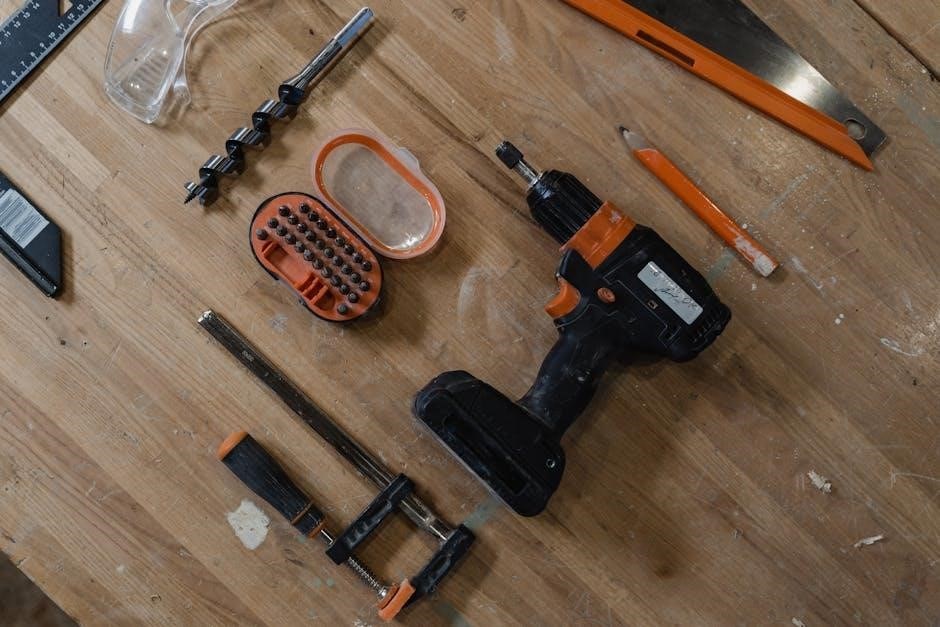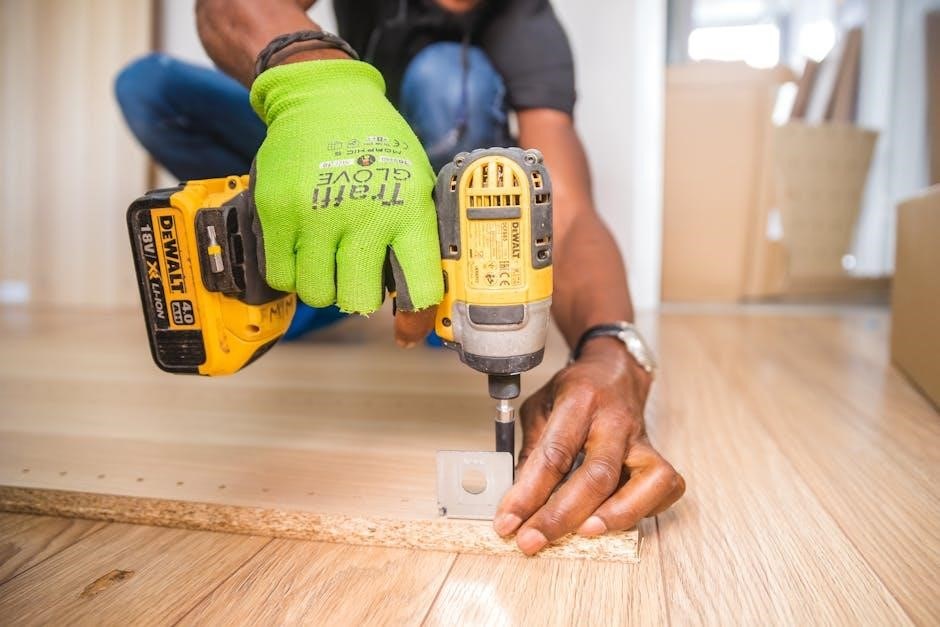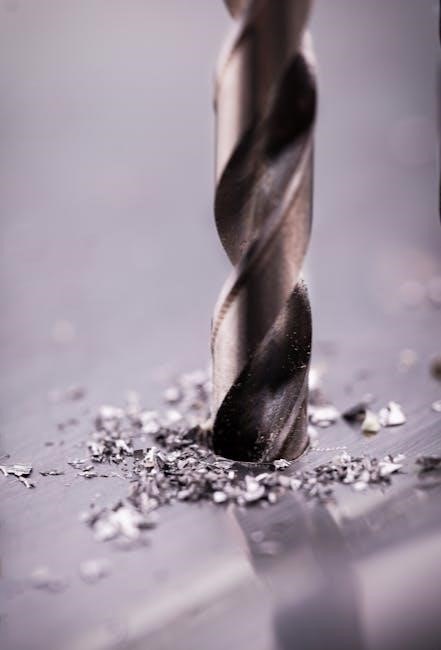This guide will introduce you to the world of drill bits‚ essential cutting tools for creating holes. We’ll explore various types‚ materials‚ and components‚ ensuring you choose the right bit for your next project.

Drill bits are indispensable tools for any DIY enthusiast or professional‚ designed for creating circular holes in various materials. From wood and drywall to metal and masonry‚ selecting the appropriate drill bit is crucial for efficiency and precision. This guide aims to demystify the world of drill bits‚ providing a comprehensive overview of their types‚ materials‚ and applications. A drill bit is a cutting tool attached to a drill. They almost always have a circular cross-section and sharp cutting points that makes it able to make holes in parts or products. The drill bits are available in a variety of sizes and shapes and can be used in various materials. Understanding the nuances of each drill bit will empower you to tackle any drilling task with confidence‚ ensuring optimal results and minimizing the risk of damage to your materials or tools.
Types of Drill Bits
The world of drill bits is vast‚ with each type meticulously engineered for specific materials and applications. Among the most common are twist drill bits‚ known for their versatility in drilling wood‚ metal‚ and plastic. Masonry drill bits‚ distinguished by their carbide tips‚ excel at boring through concrete‚ brick‚ and stone; Spade drill bits‚ with their flat blades‚ are ideal for creating large-diameter holes in wood. Other specialized bits include auger bits for deep wood drilling‚ step drill bits for creating multiple hole sizes‚ and self-feeding bits for effortless wood penetration. Selecting the right type of drill bit is crucial for achieving clean‚ accurate holes and preventing damage to both the workpiece and the drilling tool.
Twist Drill Bits
Twist drill bits are arguably the most ubiquitous type‚ recognized by their helical flutes that efficiently remove chips from the hole. These bits are general-purpose‚ adept at drilling into various materials‚ including wood‚ metal‚ plastic‚ and composites. High-speed steel (HSS) is a common material for twist drill bits‚ offering a good balance of hardness and toughness. Cobalt steel bits provide enhanced heat resistance and are suitable for drilling harder metals. Titanium-coated bits offer increased wear resistance and lubricity. Their versatility makes them a staple in any toolbox‚ ideal for both DIY projects and professional applications where precision and adaptability are key. Selecting the correct size is vital.
Masonry Drill Bits
Masonry drill bits are specifically designed for drilling into hard‚ brittle materials such as concrete‚ brick‚ stone‚ and tile. These bits feature a reinforced carbide tip‚ brazed or welded onto a steel body‚ enabling them to withstand the impact forces encountered when drilling masonry. Unlike standard drill bits‚ masonry bits often incorporate a hammer action‚ pulverizing the material ahead of the cutting edge. They are typically used with hammer drills‚ which provide both rotary and percussive force. The flute design is optimized for efficient dust removal‚ preventing clogging and ensuring consistent drilling performance. Selecting the appropriate size and using proper technique are crucial for achieving clean‚ accurate holes in masonry. Safety glasses are recommended.
Spade Drill Bits
Spade drill bits‚ also known as paddle bits‚ are designed for drilling large diameter holes in wood. They feature a flat blade with a pointed tip for centering and two cutting edges on either side. Spade bits are typically used in power drills and are best suited for creating fast‚ rough holes rather than precise‚ clean ones. They are available in various sizes‚ often ranging from 1/4 inch to 1 1/2 inches or larger. Due to their design‚ spade bits can sometimes cause splintering or tear-out‚ especially when exiting the workpiece. Using a backing board can help minimize this effect. While cost-effective‚ they are not ideal for metal or masonry.
Drill Bit Materials
The material composition of a drill bit significantly impacts its performance‚ durability‚ and suitability for different applications. Common drill bit materials include carbon steel‚ high-speed steel (HSS)‚ cobalt steel‚ and tungsten carbide. Carbon steel bits are generally used for wood drilling due to their lower heat resistance. HSS bits‚ with added alloys like chromium and vanadium‚ offer improved heat resistance and are suitable for wood‚ plastic‚ and metal. Cobalt steel bits are even more heat-resistant and are ideal for drilling harder metals like stainless steel. Tungsten carbide bits are exceptionally hard and are primarily used for masonry and other abrasive materials. Selecting the appropriate material ensures efficient drilling and extends the bit’s lifespan.
High-Speed Steel (HSS) Drill Bits
High-Speed Steel (HSS) drill bits are a popular choice due to their versatility and ability to withstand higher temperatures compared to carbon steel bits. The “high-speed” designation refers to their ability to maintain hardness at elevated cutting speeds. HSS bits are commonly used for drilling into various materials‚ including wood‚ plastic‚ aluminum‚ and mild steel. They are manufactured by adding alloys like tungsten‚ molybdenum‚ chromium‚ and vanadium to carbon steel‚ enhancing their strength and heat resistance. HSS bits are a good all-around option for general-purpose drilling tasks and offer a balance of performance and affordability‚ making them a staple in many toolboxes for both DIYers and professionals.
Tungsten Carbide Drill Bits
Tungsten carbide drill bits are renowned for their exceptional hardness and wear resistance‚ making them ideal for demanding drilling applications. These bits are composed of tungsten carbide‚ a compound significantly harder than high-speed steel. Tungsten carbide drill bits excel at drilling through abrasive materials like hardened steel‚ cast iron‚ ceramic tile‚ and even masonry. Their superior hardness allows them to maintain a sharp cutting edge for extended periods‚ resulting in cleaner and more precise holes. While more expensive than HSS bits‚ tungsten carbide drills offer a longer lifespan and improved performance in challenging materials‚ making them a worthwhile investment for specialized tasks.

Drill Bit Components
Understanding the different components of a drill bit is essential for selecting the right bit and using it effectively. Each part plays a crucial role in the drilling process. The main components include the shank‚ the flutes‚ and the tip. The shank is the part that is inserted into the drill chuck‚ determining the bit’s compatibility with the drill. Flutes are the helical grooves that run along the body of the bit‚ responsible for removing chips from the hole. Finally‚ the tip is the cutting end of the drill bit‚ and its design varies depending on the intended material.
Shank
The shank is the cylindrical or shaped end of a drill bit that is held by the drill chuck. Its diameter dictates the drill bit size and the maximum hole size achievable. Shanks come in various styles‚ including straight‚ reduced‚ hex‚ and SDS. Straight shanks are the most common‚ offering versatility for general drilling. Reduced shanks allow larger drill bits to be used in smaller chucks. Hex shanks provide a secure grip‚ preventing slippage. SDS shanks are designed for hammer drills‚ enabling efficient drilling in masonry materials. Choosing the correct shank is crucial for compatibility and optimal performance.
Flute
The flute refers to the deep‚ spiraling grooves that run along the body of the drill bit‚ extending from the tip towards the shank. These flutes serve a crucial function in the drilling process by providing a channel for removing chips and debris from the hole. Flute design also impacts the bit’s cutting efficiency and ability to dissipate heat. Flute length and shape are important considerations when selecting a drill bit. Wider flutes are better for softer materials‚ while narrower flutes are more suitable for harder materials. Proper flute design ensures clean‚ efficient drilling‚ minimizing the risk of clogging or overheating.
Tip
The tip of a drill bit is the business end‚ the part that initiates contact with the material and performs the actual cutting. You can find a range of tip types‚ each designed for specific purposes and materials. Some tips are simple conical shapes‚ while others feature specialized geometries like split points or brad points. The angle and sharpness of the tip determine the bit’s aggressiveness and ability to center itself accurately. A well-designed tip minimizes walking or wandering‚ ensuring precise hole placement. Different tip materials‚ such as carbide or cobalt‚ enhance durability and cutting performance in challenging materials. Selecting the correct tip is crucial for achieving optimal drilling results.

Applications of Drill Bits
Drill bits are incredibly versatile tools‚ finding applications across numerous industries and DIY projects. In woodworking‚ they create holes for screws‚ dowels‚ and joinery. Metalworking relies on drill bits for manufacturing components‚ creating threaded holes‚ and deburring. Construction utilizes them for installing anchors‚ running wiring‚ and creating pilot holes in masonry. Home improvement tasks like hanging shelves‚ assembling furniture‚ and running cables depend on drill bits. The specific application dictates the type of drill bit required‚ considering the material being drilled‚ the desired hole size‚ and the necessary precision. From delicate electronics work to heavy-duty construction‚ drill bits play a vital role in creating and assembling the world around us.
Choosing the Right Drill Bit

Selecting the appropriate drill bit is paramount for achieving optimal results and ensuring safety. Consider the material you intend to drill‚ as different materials require specific bit types. For instance‚ masonry bits are designed for concrete and brick‚ while high-speed steel (HSS) bits excel in metal. Determine the desired hole size‚ matching the bit diameter to your project’s specifications. Factor in the depth of the hole‚ selecting a bit with sufficient flute length. Evaluate the drill’s capabilities‚ ensuring compatibility with the bit’s shank size. Prioritize quality and durability‚ opting for reputable brands and materials that can withstand the demands of the task. Proper selection minimizes damage‚ enhances efficiency‚ and extends the lifespan of both the drill and the bit‚ contributing to successful outcomes.



